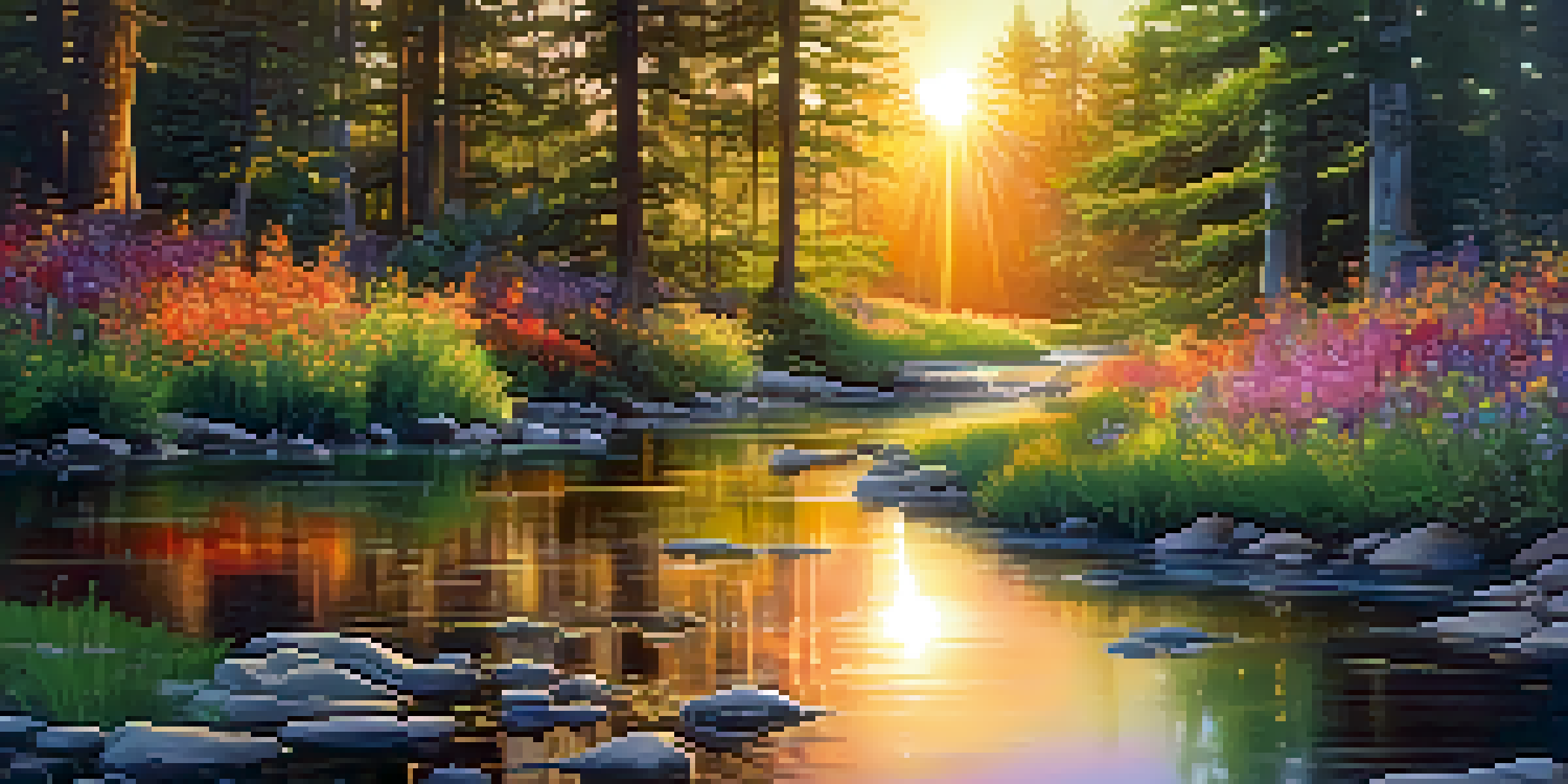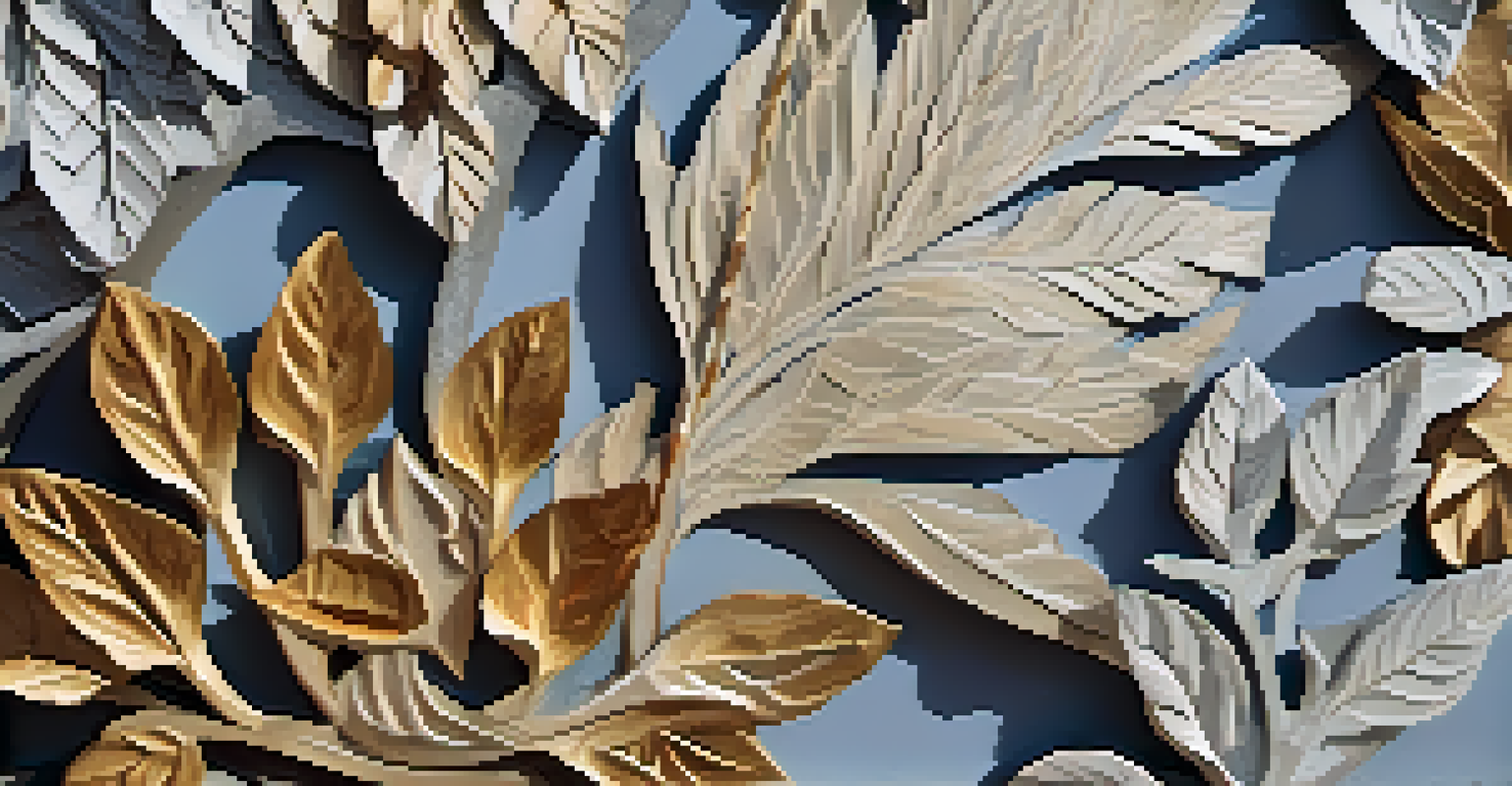Exploring Nature's Beauty: Art Inspired by Environmental Issues

The Intersection of Art and Environmental Awareness
Art has always been a powerful medium for expression, and when it intersects with environmental issues, it creates a profound impact. Artists often use their work to address topics like climate change, pollution, and biodiversity loss. By presenting these challenges visually, they can provoke thought and inspire action among viewers.
Art is not a mirror held up to reality, but a hammer with which to shape it.
For instance, consider the works of artists like Olafur Eliasson, who uses light and space to engage audiences with the beauty of nature. His installations often encourage us to reflect on our relationship with the environment. Through such art, viewers can see the urgency of environmental issues in a new light.
Ultimately, the fusion of art and environmental awareness not only raises awareness but also fosters a deeper emotional connection to the planet. This connection is essential for motivating individuals to take action in their own communities.
Nature as a Muse: Artists Drawing Inspiration from the Environment
Nature has long served as a source of inspiration for artists around the world. From the sweeping landscapes of the Romantic era to contemporary installations that mimic natural forms, the environment has shaped countless artistic expressions. This ongoing relationship between art and nature highlights the beauty of our surroundings and the need for their preservation.

Take the example of Georgia O'Keeffe, whose vibrant paintings of flowers and landscapes celebrate the intricate beauty of the natural world. Her work invites viewers to appreciate the subtleties of nature, effectively conveying a message about the importance of conservation. Through her art, O'Keeffe encourages a deeper connection with the environment.
Art Sparks Environmental Awareness
Artists use their work to address pressing environmental issues, inspiring viewers to reflect and take action.
By showcasing nature's beauty, artists not only celebrate it but also remind us of what is at stake. Their work serves as a call to action, urging us to protect and preserve the natural world for future generations.
Art as a Catalyst for Environmental Activism
Art has the unique ability to inspire activism and provoke societal change. Many artists leverage their platforms to advocate for environmental issues, using their creations as a vehicle for awareness. This activism can take many forms, from public installations to social media campaigns that highlight pressing concerns.
The greatest threat to our planet is the belief that someone else will save it.
Consider the work of Banksy, whose street art often addresses social and environmental issues. His thought-provoking pieces challenge viewers to reconsider their perspectives and spur conversations about topics like waste and consumerism. By placing these messages in public spaces, he reaches a wide audience and ignites discussions that could lead to meaningful change.
In this way, art becomes more than just a visual experience; it transforms into a movement for progress. Artists empower individuals to take ownership of environmental issues, fostering a collective responsibility towards the planet.
Documentary Art: Capturing Environmental Issues
Documentary art serves as a powerful tool for capturing real-life environmental issues. Through photography, film, and other media, artists can document the effects of climate change, habitat destruction, and pollution on our planet. This form of art provides a compelling narrative that can move audiences emotionally and intellectually.
For example, the photography of Sebastião Salgado offers breathtaking views of nature alongside stark images of ecological devastation. His work encourages viewers to confront the realities of environmental degradation while showcasing the beauty that still exists. This duality serves to highlight the urgent need for action.
Nature Inspires Artistic Expression
The beauty of nature serves as a muse for artists, highlighting the need for conservation through their creations.
By presenting these narratives, documentary art not only informs but also motivates change. It invites viewers to reflect on their role in the ongoing environmental crisis and encourages them to take steps towards solutions.
Eco-Art: Creating Sustainable Practices in Art
Eco-art is a movement that emphasizes sustainability and environmental consciousness in artistic practices. Artists involved in this movement often use recycled materials or engage in practices that minimize environmental impact. This approach not only reduces waste but also sends a powerful message about the importance of sustainability.
One notable example is the work of artist Chris Jordan, who creates large-scale images using consumer waste to illustrate the scale of overconsumption. His art serves as a stark reminder of the environmental consequences of our choices. By using discarded materials, he transforms waste into thought-provoking visual commentary.
Eco-art thus serves as a bridge between creativity and environmental responsibility. It challenges artists to innovate while also considering the impact of their work on the planet.
Community Art: Engaging Local Audiences with Nature
Community art projects often focus on local environmental issues, bringing together artists and residents to foster a sense of collective ownership. These initiatives encourage community members to engage with their environment while promoting awareness of local challenges. Through collaborative efforts, art can enhance community cohesion and inspire action.
For instance, murals depicting local flora and fauna can beautify neighborhoods while educating residents about their local ecosystem. These projects not only create visually appealing spaces but also encourage conversations around conservation efforts. Local art becomes a powerful reminder of the importance of preserving one's surroundings.
Art Fuels Environmental Activism
By leveraging their platforms, artists transform their creations into powerful tools for social and environmental change.
By engaging communities in artistic expression, these projects empower individuals to take pride in their natural environment. They foster a shared responsibility for protecting and nurturing the ecosystems we inhabit.
The Future of Art and Environmental Advocacy
As we move forward, the relationship between art and environmental advocacy will likely continue to evolve. With growing awareness of climate change and environmental degradation, artists are increasingly using their work to address these critical issues. This shift signals a broader cultural change, where art serves not only as a form of expression but also as a means of activism.
Technological advancements also play a role in shaping this future. Virtual reality, augmented reality, and social media provide new avenues for artists to showcase their work and reach global audiences. These tools can enhance the impact of environmental messages, allowing for immersive experiences that resonate deeply with viewers.

Ultimately, the future of art and environmental advocacy is bright. By harnessing creativity and innovation, artists can continue to inspire change and engage people in the urgent conversation about our planet's health.